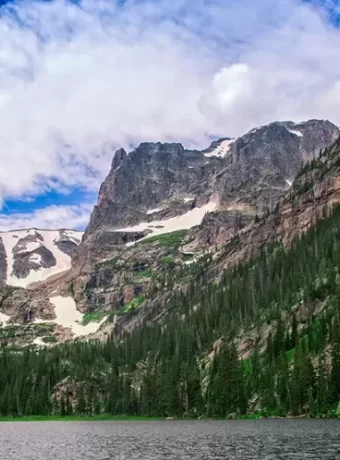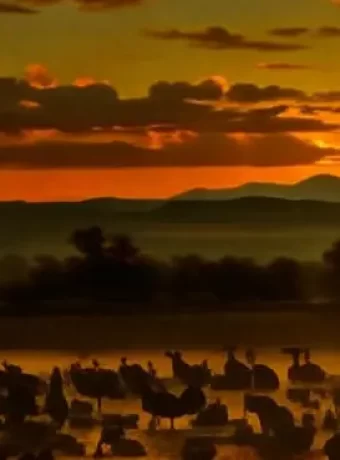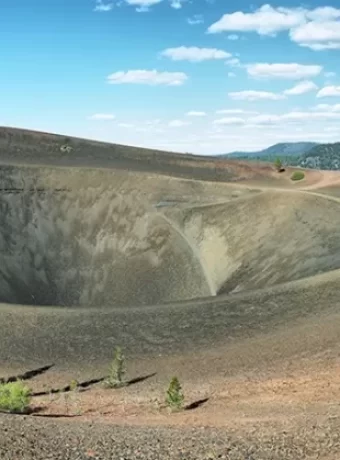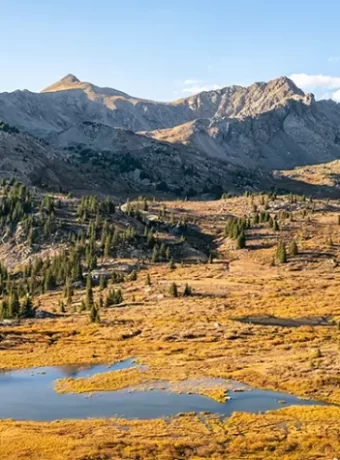Hiking & Backpacking Wind River Range: A Trail Guide
Set your sights on the Wind River Range, where trails wind through a landscape as raw and rugged as it is breathtaking. By trekking these paths, you’re in for an experience that’s both grounding and exhilarating. With access to both Bridger-Teton National Forest and Shoshone National Forest, along with slices of the Wind River Indian Reservation, hiking backpacking wind river range means stepping into a world brimming with natural splendor.
You’ll learn about preparing for this remote wilderness: what gear to pack, how to navigate weather surprises, plus routes that promise postcard-worthy vistas around every bend. Whether seeking serene lakes or challenging high alpine climbs—your adventure awaits.
Table Of Contents:
- Overview of the Wind River Range
- Planning Your Backpacking Adventure in the Wind River Range
- Iconic Backpacking Routes in the Wind River Range
- Gear Essentials for Hiking and Backpacking in the Wind River Range
- Ensuring Safety While Exploring the Wilds of Wind River
- Camping Options Across The Winds
- The Scenic Majesty Of Titcomb Basin And Beyond
- The Complete High Route Experience
- Tackling Wildlife And Nature Head-On In The Winds
- FAQs in Relation to Hiking Backpacking Wind River Range
- Conclusion of Hiking Backpacking Wind River Range
- Leave the Winds Next Stop British Columbia
Overview of the Wind River Range
Discover the majestic Wind River Range, a pristine section of the Rocky Mountains known for its rugged wilderness and diverse ecosystems. Learn about its location within national forests and reservations, and what makes it a premier destination for backpackers.
Securing Trailhead Parking
Finding your gateway into this remote paradise starts at trailheads like Big Sandy or Elkhart Park—and trust me when I say parking spots fill up faster than cups during a water break on a hot day hike. Make sure you arrive early if you want to snag a spot at these popular jumping-off points before setting out on trails that weave past gems like Seneca Lake Trail or Titcomb Basin.

Layering with sun protective, hydrophobic Graphic Outdoor Apparel.
If there’s anything more important than securing parking, it might be grabbing detailed guides essential for navigation across The Winds’ extensive network of paths. Don’t count solely on whimsy; let top-notch resources guide your way.
Utilizing Detailed Guides for Navigation
To traverse such an intricate tapestry of routes—with over 600 miles ribboning through Continental Divide vistas—it pays to have detailed maps tucked safely next to your gear essentials. Sure-footedness comes not only from sturdy boots but also armed knowledge gained by poring over topographical charts or consulting digital tools pinpointing everything from creek trails to summit lake waypoints within this grand climbing wildernesses.
Dive deep into preparations so that once feet hit dirt tracks winding toward destinations like Lonesome Lake or Pole Creek Trail, every step is informed by research done well ahead under less star-studded skies—because getting lost isn’t part of our itinerary.
Planning Your Backpacking Adventure in the Wind River Range
If you’re gearing up for a backpacking trip through Wyoming’s wild heart, the Wind River Range beckons with its unspoiled beauty. Before lacing up those boots, let’s talk trailhead parking—a starting point as crucial as your first cup of coffee.
Securing Trailhead Parking
Finding a spot for your ride isn’t always easy peasy. Popular launch points like Elkhart Park overflow by early afternoon during peak season. To avoid circling around like an eagle scouting prey, aim to hit that parking lot bright and early—or better yet, camp nearby the night before. For more off-the-beaten-path trailheads such as Big Sandy Opening or Green River Lakes, roads can be rough but spaces plentiful—just check ahead with Bridger-Teton National Forest rangers on current conditions so you don’t end up stuck in no man’s land.
In places where wilderness meets civilization like Sinks Canyon State Park at the foot of Wind River Peak or even along remote stretches near Gannett Peak, parking logistics may vary widely from dusty gravel lots to structured areas with posted regulations—so keep an eye out for signage and local wisdom.
Utilizing Detailed Guides for Navigation
You wouldn’t trek into Mordor without Gandalf; similarly, navigating this expansive backcountry maze calls for detailed guides worthy of any intrepid explorer’s pack. Surefire companions include topographic maps and GPS devices loaded with tracks straight from seasoned wanderers who’ve charted these lands extensively—you might not find a yellow brick road here but having trustworthy navigation aids is golden.
The extensive network of trails including Pole Creek Trail and Seneca Lake Trail weave through terrain varying from gentle creek-side paths to rugged granite slabs inviting high alpine climbing adventures. No magic spells needed—grabbing one of Michael Lanza’s e-guides to classic backpacking trips, will help guide your steps across Continental Divide vistas or deep into Titcomb Basin without missing out on hidden gems scattered throughout The Winds’ 100-mile expanse.
An understanding of trail miles comes handy when planning day hikes versus full-on treks—if Island Lake whispers tales over just 10 miles roundtrip while Cirque Of Towers Loop teases you further beyond with a robust 43-mile loop adventure taking about five days; knowledge is power (and saves sore feet).
- The Pole Creek Trail offers a stunning pathway to picturesque lakes, making it a must-visit for nature photographers and outdoor enthusiasts alike.
Start your Wind River Range adventure right by tackling trailhead parking early or camping close the night before. Always bring detailed guides, like topographic maps and GPS tracks, to navigate this wild terrain without a hitch.
Iconic Backpacking Routes in the Wind River Range
Embark on an unforgettable journey hiking backpacking the Wind River Range, where alpine lakes and rugged peaks await your discovery. Explore some of the most beautiful alpine landscapes in America by following classic backpacking routes that showcase spectacular high alpine terrains. Picture this: a 43-mile loop weaving through spectacular high alpine terrain that could take five days to complete. It’s like stepping into another world, where each trail leads you deeper into nature’s heart.
If your boots are itching for adventure, then backpacking routes such as the classic Cirque of the Towers or Titcomb Basin should top your list. They’re not just walks in the park; they’re passages through raw wilderness that will leave you awestruck at every turn.
Securing Trailhead Parking
Finding parking can be tricky with spots filling up faster than a flash flood. Your best bet is to arrive early morning or even better, midweek when crowds thin out. The Elkhart Park trailhead is a popular starting point for many treks including those heading towards Island Lake and Seneca Lake Trail—so plan accordingly.
Parking logistics aside, once you’re on foot and trekking along Pole Creek Trail or Green River Lakes trails, all stress fades away against backdrops fit for postcards.
Utilizing Detailed Guides for Navigation
A map might show you where to go but it won’t tell tales of what lies ahead nor whisper tips passed down from seasoned hikers—that’s why detailed guides are gold dust here in The Winds. Michael Lanza’s e-guides give insider knowledge that turns good trips great by revealing hidden gems off beaten paths.
Seriously consider these resources before venturing out because getting lost isn’t as fun as it sounds—not even close.
Gear Essentials for Hiking and Backpacking in the Wind River Range
Your gear checklist should include more than just a base camp setup—it needs resilience against Mother Nature’s mood swings here among towering peaks. Think durable tents capable of withstanding sudden storms plus sleeping bags cozy enough to make chilly nights bearable after day hiking across granite slabs beneath continental divide skies…
I would like to give thanks to Kelty and Klymit Gear for all of their support over the years.

Wind River Graphic Hoodie hiking apparel design for the active outdoors person.
Dress layers deep too since weather changes quicker than mindsets around here… And don’t forget food storage solutions unless sharing meals with grizzly bears sounds appealing (hint: it shouldn’t).
Tips:
- Select lightweight yet sturdy gear designed specifically for backpacking trips.
- Investigate water purification methods suited best based on river lake sources available.
Wind River Range Hiking Tip:
Hit the Wind River Range trails like a pro with early parking, detailed guides for secret spots, and gear that stands up to mountain weather. Remember: layers are your friends and grizzlies aren’t dinner guests.
Gear Essentials for Hiking and Backpacking in the Wind River Range
When you’re gearing up to tackle the trails of the Wind River Range, think of yourself as a modern-day explorer. You wouldn’t catch Lewis and Clark without their essentials, so why should you be any different? Let’s break down what gear will serve as your best allies out there.
Selecting Your Base Camp Setup
The base camp is your home away from home; it’s where stories are shared under starlit skies after a day on the trail. To set yours just right, prioritize durability and weight—a delicate balance like that between rugged mountains and open sky. A lightweight tent with robust weather protection will shield you from those unexpected high-altitude storms.
Pair this shelter with a sleeping bag rated for temperatures below what you expect—mother nature loves throwing curveballs—and an insulated pad because comfort shouldn’t be compromised when it’s time to recharge.
Durable Camping Gear: The Backbone of Any Trip
Your backpack is essentially your trusty steed—it carries all that you need across diverse terrains. Opt for one that hugs your back comfortably but stands tough against granite slabs or brushes through dense forests within Bridger-Teton National Forest territory. Remember capacity too; something around 50-70 liters works wonders for managing both short jaunts or extended expeditions through alpine meadows dotted with bighorn sheep sightings.
Cookware needs to strike hot when hunger calls in cool early afternoon breezes by Green River lakes or at Island Lake vistas. Compact stoves are golden here alongside easy-to-clean utensils made from hard-anodized aluminum—they resist scratching much like Gannett Peak resists easy conquests.
Navigational Tools: Don’t Leave Home Without Them
Even if navigating Pole Creek Trail feels second nature, always pack reliable maps along with GPS devices—or both if redundancy makes your heart feel secure as Elkhart Park does to hikers setting off into these wildernesses teeming with adventure potential near Continental Divide splendor.
A compass doesn’t run out of batteries either—much like how Seneca Lake trail can seem never-ending until its waters suddenly grace our sightline after miles walked amidst whispering pines on creek trails lesser-known than Big Sandy’s popularity streak among outbound community chatterers eager for tales about lonesome lake solitude or summit lake sunrises witnessed alone but felt together in collective awe over such scenic majesty only Wyoming offers this boldly.
Footing It Right: Footwear That Goes The Distance
Hitting each step confidently requires boots built solidly yet able to flex with your movements. It’s all about finding that balance between durability and comfort.
Get your gear right for the Wind River Range: durable, lightweight tents, cold-rated sleeping bags and pads, comfy yet tough backpacks around 50-70 liters, compact cookware from hardy materials. Don’t forget maps and GPS plus a trusty compass – your lifelines on the trail.
Ensuring Safety While Exploring the Wilds of Wind River
The wilds of Wind River are a hiker’s paradise, but they’re also home to grizzly bears and bighorn sheep. So when you hit these trails, it pays to keep your wits about you. To stay safe in this remote area, be savvy about wildlife encounters and prepared for sudden weather changes.
Hiking Backpacking Safety Tips
Bear safety is non-negotiable here. Store food in bear-proof containers and know how to use bear spray—think of it as a seatbelt; you hope not to need it but buckle up anyway. If we’re talking numbers, staying at least 100 yards away from bears isn’t just good sense—it’s park policy. Remember that while bighorn sheep may look less daunting than their larger cousins, giving them space is still key.
Frequent thunderstorms bring another level of thrill—and risk—to hiking or backpacking in the range. Lightning strikes aren’t just dramatic; they’re dangerous. Start your hikes early so you can reach lower elevations by early afternoon when storms typically roll through.
Weather Preparedness: Your Best Defense Against Nature’s Surprises
You’ll want gear that stands up against whatever the sky decides to drop on you—thunderstorm or snow flurry (yes, even in summer). Quick-dry clothing will serve you well during unexpected downpours, while layers are essential for adapting quickly as temperatures swing from one extreme to another.
An eye on the skies won’t hurt either—but let’s face it—the mountains have a way of doing what they want regardless of forecasts. That said if dark clouds start piling up like unpaid bills, take that cue seriously and head for safer terrain before nature shows its full hand.
Navigating The Unpredictable Terrain And Wildlife Of The Winds
Moving through this untamed landscape means respecting its unpredictability—you might find yourself facing off with granite slabs instead of smooth trail paths or having an unexpected encounter with local fauna like those aforementioned grizzly bears or majestic bighorn sheep lurking around Elkhart Park Trailhead parking lot—or anywhere else really.
To help prevent becoming disoriented amidst alpine flora across different elevations (which could happen because let’s admit – sometimes nature likes messing with us), always carry detailed maps along Pole Creek Trail and beyond into Bridger-Teton National Forest territory—even if GPS technology is tagging along too.
Remember folks: This isn’t Central Park where squirrels are your biggest concern. Out here among spectacular high alpine climbs within Shoshone National Forest boundaries, you’ve got to stay sharp. The terrain is unforgiving and the wildlife plays for keeps. So gear up, keep your wits about you, and savor every moment of adventure in this untamed wilderness.
Stay sharp in Wind River’s wilds: pack bear spray, steer clear of wildlife, and dress for fast-changing weather. Keep an eye on the sky and hit trails early to dodge afternoon storms. Trust your map over tech—it’s real-deal territory out here, not a city park stroll.
Camping Options Across The Winds
Imagine unzipping your tent to the cool breeze of the Wind River Range, where camping options are as varied as the peaks themselves. Whether you’re looking for backcountry solitude or a lakeside haven, ‘The Winds’ have got you covered. You like stars on a warms clear summers night. This is one of the great places to get lost in the stars.
Backcountry Camping Rules
The Bridger-Teton National Forest and Shoshone National Forest cradle much of this region, offering countless spots for setting up camp under starlit skies. But with great beauty comes great responsibility—backcountry rules are strict here to preserve the wilderness vibe we all cherish. Before heading out on trails like Seneca Lake Trail or venturing near Gannett Peak, make sure you know what’s expected from every camper in terms of waste disposal and wildlife safety measures.
To keep it pristine for everyone following in your boot prints, dispersed camping regulations dictate that campsites must be at least 200 feet away from trails and water sources like Green River Lakes or Island Lake. And remember folks, leave no trace; whatever comes in with you should head right back out tucked safely in your pack.
Designated Campsites & Dispersed Camping Regulations
If flying by the seat of your pants isn’t quite how you roll when wandering through Elkhart Park or marveling at Big Sandy Opening vistas—you’ll want to get familiar with designated campsites dotting Pole Creek Trail and other popular routes within The Winds’ embrace. These spots often feature existing fire rings (where fires are allowed) and occasionally pit toilets—a luxury when deep in nature’s grasp.
Lonesome Lake whispers its call to those desiring a more defined overnight spot while still basking amid granite slabs towering overhead; just don’t forget about securing trailhead parking before making tracks toward these little slices of heaven. It’s worth noting though that some areas may require permits so do check beforehand via reliable resources such as Bridger-Teton National Forest.
Tackling Popular Trails While Keeping Wilderness Wild
You’ve laced up boots ready for day hiking bliss but think ahead—the Wind River Indian Reservation bounds part of this range too. Access there is different: specific passes might be needed if paths lead onto reservation lands bordering Elbow Lake or Summit Lake expanses.
For backpackers yearning off-trail adventures along Continental Divide spines leading into titillating Titcomb Basin views—it’s crucial to balance respect for both land rights and ecological integrity against our natural urge to explore every corner offered by mother nature’s rugged playgrounds.
Wake up to the Wind River Range’s crisp air and diverse camping spots, from backcountry quietness to lakeside retreats. Know the rules: keep camps 200 feet from trails and water, pack out your trash, use designated sites with fire rings when available, and check for permits—adventure awaits while preserving wilderness.
The Scenic Majesty Of Titcomb Basin And Beyond
Titcomb Basin stands as a jewel in the crown of the Wind River Range, flanked by Green River Lakes and overshadowed by towering peaks that etch against Wyoming’s big skies. It’s where alpine enthusiasts find their slice of heaven, with trails like Seneca Lake Trail winding through wildflower meadows before reaching Lonesome Lake’s reflective waters. These landscapes aren’t just postcard-worthy; they’re an immersive experience for anyone willing to strap on a pack and tread into the heartland of America’s vast wilderness.
Towering Peaks That Guide Your Journey
Imagine setting out at early afternoon from Elkhart Park trailhead parking lot, your boots crunching on gravel as you begin your ascent towards Seneca Lake Trail. With each step, the elevation gains—measured not just in ft gain but also in escalating awe—as granite slabs rise majestically around you. Here, Gannett Peak looms large: Wyoming’s highest point beckons ambitious hikers seeking high alpine climbing adventures without technical gear requirements.
The trail route continues past Island Lake—a gem set among classic Wind River Range vistas—and invites day hiking aficionados to explore its serene shores or perhaps catch sight of bighorn sheep grazing nearby. The journey is more than a mere trek; it’s about becoming part of this untamed landscape where every turn offers another dramatic vista.
A Tapestry Of Aquatic Wonders
Beyond titanic peaks lies an intricate network of river lakes including Green River Lakes—glacial bodies that mirror sky and stone alike—creating panoramas that defy expectations. Pole Creek flows gently here while it carves pathways through lush valleys leading adventurers deeper into Bridger-Teton National Forest lands known for their pristine ecosystems and unparalleled tranquility.
Creek trail after creek trail unveils new chapters in this epic narrative: Big Sandy opening up to expansive views over clear water; Summit Lake nestled amidst craggy summits offering solace to weary travelers; Elbow Lake peeking shyly from behind spruce-fir curtains—a tableau vivant framed perfectly within nature’s grand design.
Traversing The Continental Divide In Solitude
In these parts, even something as monumental as crossing the Continental Divide becomes an intimate affair between you and nature itself—the quiet rustle of pine needles underfoot accompanying thoughts drifting like clouds above Elkhart Park are enough proof that solitude can be found even across such legendary divides.
Bridger-Teton National Forest covers a vast area, and it’s teamed up with lands overseen by Wind River. Together, they form an expanse of wilderness that beckons outdoor enthusiasts from all corners. So whether you’re into hiking, fishing, or just soaking in the natural beauty, this place has got you covered.
The Complete High Route Experience
Traversing the Wind River Range via The High Route is like playing a symphony with your feet—every step must be deliberate, every pause intentional. This journey is not for those who seek groomed paths; it’s an off-trail odyssey that tests one’s mettle against granite slabs and open wilderness.
Navigating Off-Trail Sections
Tackling The High Route demands more than just physical stamina—it requires sharp navigation skills to conquer its unmarked territories. To traverse these remote expanses successfully, you’ll need detailed guides as your compass through the unpredictable terrain of the Winds. As no technical climbing is required, even adventurers without mountaineering expertise can embark on this epic high alpine trek—but don’t let that fool you into complacency.
A reliable guide becomes indispensable when navigating complex landscapes where trails fade into nature’s canvas. Imagine deciphering routes in a vast painting of rocky outcrops and lush meadows—this experience elevates hiking to an art form reserved for true backcountry connoisseurs.
Climbing Granite Slabs
Your encounter with The Winds’ infamous granite slabs will feel less like climbing and more like a vertical dance across nature’s architecture. These colossal natural structures command respect but offer exhilaration in return as they pave unconventional pathways towards spectacular vistas above tree line.
To engage these stone giants without ropes or picks speaks to their accessibility—a climber’s spirit housed within every hiker can find expression here amidst windswept ridges and panoramic summits akin to Gannett Peak’s majesty looming over all else. But always remember: respect for this landscape means recognizing both its beauty and its potential dangers.
With each phase of your adventure across Wyoming’s most rugged expanse—the very spine of the Continental Divide—you’ll stitch together unforgettable memories made from summit sunrises at Island Lake or serene moments beside Lonesome Lake.
So gear up, set foot from Elkhart Park Trailhead parking lot early afternoon if possible (to snag that prime spot), chart course by Pole Creek Trail, embrace Big Sandy underfoot because ahead lies one classic Wind River range backpacking story waiting to unfold beneath your boots.
To delve deeper into planning transformative hikes in Bridger-Teton National Forest, just click here. For practical advice on logistics, such as trail mile knowledge and preparation tips, check out Michael Lanza’s e-guides. I found them useful.
The High Route in the Wind River Range is an off-trail challenge blending navigation, stamina, and respect for nature. It’s a high alpine adventure without technical climbs but demands careful route-finding across granite slabs to breathtaking vistas.
Tackling Wildlife And Nature Head-On In The Winds
Embark on a journey through the Wind River Range is like stepping into an untamed gallery of nature’s finest artwork, where bighorn sheep scale steep mountainsides with ease and grizzly bears roam as lords of their realm. Here, every twist in the trail can lead to encounters with wildlife that command respect and caution.
Bighorn Sheep: Masters of Elevation
The bighorns are more than just iconic—they’re a testament to life adapted at high altitudes. These robust creatures inhabit the alpine flora-rich landscapes across different elevations, offering hikers mesmerizing sights against backdrops of rugged peaks. Observing them demands patience; they blend seamlessly into their surroundings thanks to natural camouflage.
While day hiking or tackling longer backpacking trails, keep your eyes peeled for these agile climbers around Elkhart Park or along Seneca Lake Trail. It’s common for trekkers traversing this terrain to spot herds grazing near Island Lake or silhouetted against Summit Lake’s reflective waters.
Grizzly Bears: A Presence That Commands Respect
In contrast to the nimble-footed sheep, grizzlies assert dominance simply by existing within these woods and meadows—a reminder that we’re visitors in their home territory. Hiking through areas like Bridger-Teton National Forest means entering bear country; hence safety becomes paramount. Carry bear spray, make noise while you hike especially in dense brush or near running water where sound travels poorly—letting these solitary giants know you’re there could save both parties from startling surprises.
Camping brings its own set of rules when it comes to coexisting with bears. Use bear-proof containers for food storage whether overnighting at Green River Lakes campsites or finding solitude by Lonesome Lake—the goal is always minimizing impact and keeping wild inhabitants undisturbed by our presence.
Alpine Flora: Delicate Beauty Amidst Ruggedness
Moving beyond megafauna encounters, immersing yourself among Wind River’s unique plant life offers a gentler but equally captivating aspect of wilderness exploration—where vibrant blooms burst forth from granite slabs underfoot making each step feel like moving through an Earthly mosaic crafted over millennia. Bridger-Teton National Forest, particularly renowned for its floral diversity due partly because here Continental Divide creates microclimates ideal for various species’ growth—from lush meadow grasses swaying beside creek trail routes all way up until sparse yet resilient lichen communities holding onto windswept ridges above 10k ft gain thresholds.
Step into the wild of the Wind River Range and you’ll find yourself amid nature’s masterpieces, from bighorn sheep to grizzly bears. Keep your eyes open for these animals while respecting their home turf.
Stay safe in bear country by making noise and storing food properly. Discover vibrant plant life that thrives amidst this rugged beauty, completing your wilderness adventure.
FAQs in Relation to Hiking Backpacking Wind River Range
Do you need a permit to backpack in the Wind River Range?
No permits required, but trailhead parking spots can fill up. Arrive early or consider weekdays.
When should I backpack at Wind River Range?
Summer months are prime time. Aim for July through September when trails are snow-free and lakes thawed.
Where is the best backpacking trail in Wind River Range?
The Cirque of the Towers offers breathtaking scenery; it’s a hiker favorite for good reason.
How many miles do backpackers hike a day?
Hikers typically log 10-15 miles daily, depending on terrain and fitness levels.
Conclusion of Hiking Backpacking Wind River Range
So you’re set on hiking backpacking the Wind River Range. Remember, this journey will test your limits and reward you with untamed beauty. Make sure to secure parking at trailheads early and map out those miles.
Equip yourself properly; pack smart for weather shifts and rugged terrain. You’ll be sharing space with wildlife, so stay aware—especially near river peaks where grizzly bears roam.
Pick a route that fits your skill level, from classic trails to challenging high alpine climbs. Whether it’s lakes or towering peaks calling you, prepare well.
Honor the land as you go through national forests or cross into reservation territory; respect is key in these sacred spaces.
In every step of planning and executing your trek across this majestic range—the memories made will last a lifetime because adventure lives here in the Wind River Range.
Leave the Winds Next Stop British Columbia
Fortress Lake with a rivaling wilderness experience. Fly fishing in Montana, or Denmark Fly Fishing.








